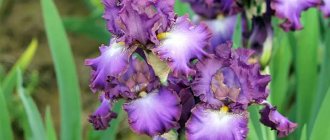Brief information about the plant, popular types
The name phlox comes from Greek and means flame, which is why the plant is called flame in some countries. In nature, these perennial flowers grow in the moist forests of North America, and only one species comes from Siberia. They are undemanding plants, so growing and caring for phlox is an enjoyable gardening activity.
These perennials grow well in sunny or light partial shade in fertile, permeable soil with added peat. Plants take a large amount of nutrients from the soil, so they are rarely replanted - every 5 years.
In gardening practice, phloxes are simply divided into:
- low and high;
- perennial and annual flowers.
Paniculate inflorescences look great in bouquets, so they are suitable for cut flowers.
Phlox is also grown as a potted flower on terraces.
Brief information about cultivation:
- position – sunny or semi-shaded places;
- watering – it is important to water the plants regularly and generously;
- the soil is fertile, rich in humus, permeable, before planting it is worth enriching the soil with compost;
- cultivation - it is necessary to maintain a moist substrate; when the flowers fade, you need to cut them off, new shoots will appear that will quickly bloom;
- Caring for phlox in the fall involves autumn pruning.
The most commonly cultivated species include:
- Phlox paniculata, imported to Europe in the 18th century, has been cultivated in gardens since the 19th century. Today, paniculate varieties are also grown on balconies.
- Douglas phlox is a low-growing variety.
- Loose-grass (Canadian, splayed) phlox is low-growing.
- Carolinas are short-growing.
All types are suitable for creating rocky gardens and rockeries. It is also worth highlighting an interesting species - drummond phlox.
What varieties are suitable
99% of phloxes are perennial crops. Some species and varieties are hybrid. One annual phlox - Drummonda. Thanks to the diversity and brightness of the flower, it quickly gained popularity. External charm forces you to acquire several types at once.
Interesting fact! Phloxes are varied in color and shape. And also the type and duration of flowering. But there is one peculiarity in the culture: yellow or yellowish phloxes do not exist in nature. Blue tones predominate.
Paniculate
It differs from most species in its variety of colors. The palette is added by lush inflorescences. Hats can be:
- purple;
- purple;
- carmine;
- white;
- all shades of pink and blue.
Phlox propagation - vegetative, by seeds
Phloxes are propagated in 3 ways:
- dividing the bush;
- using apical or root cuttings;
- seeds.
The simplest method of propagating phlox is dividing plants, done in autumn or spring. Flowers are also propagated using root and stem cuttings. This is done in the fall or spring.
You can collect phlox seeds in the fall. Plants from seeds are grown at home or sown directly into the soil. Flowers sown in pots will decorate window sills in early spring.
Planting, fertilizer
The best date for planting flowers is September, October. Phlox are planted according to a pattern of 40 by 70 centimeters.
Feed the plant in spring and autumn with organic fertilizers:
- compost;
- rotted manure.
Attention! Phlox paniculata varieties do not like the application of manure.
You can fertilize phlox using foliar fertilizers:
- Actifos;
- Solfan PK, Baymat Ultra 0.015 AE.
Spraying is carried out in the evening, at air humidity of 60-80 percent.
Pruning in summer and autumn
After flowering, phloxes need pruning. The top parts of the plants are removed so that they will grow well. If you leave faded inflorescences, self-dispersal occurs.
Summer pruning
July-August is the time when phloxes fade. There are different opinions on whether phlox should be pruned in summer. To prolong flowering, it is worth cutting off the inflorescences; after 1-2 weeks they will appear and bloom again. New inflorescences will grow in the leaf axils below the cutting site. They won't be as big as the first ones, but their wonderful smell will remain the same. Phloxes have a beautiful shape and bloom profusely in both sunny and semi-shaded places. In full sun they bloom earlier than in the shade.
Individual growth points in the inflorescence do not develop simultaneously with the others. Therefore, when the former disappear, the latter are just beginning to develop. The inflorescences are cut off when more than half of the flowers have faded.
Some gardeners cut off the blooming inflorescence after noticing a few faded flowers. This is a matter of taste - the phloxes will bloom again after a while.
At what height should I trim the inflorescences? Paniculate varieties are pruned under the last branching of shoots with inflorescences. In the picture below, the cutting location is indicated with a red line. The picture on the right shows the re-blooming of phlox after pruning. Flowers no longer form one large inflorescence, but form several smaller ones on the sides of the stem.
Phlox quickly sets seeds and easily reproduces from them. Therefore, if green seed boxes appear on the inflorescences (marked in red in the photo below), it is better not to throw them into the compost. Phloxes with compost are spread throughout the garden, creating multi-colored hybrids.
Autumn pruning
An important stage of care is preparing flowers for winter. Phlox completely stop blooming at the turn of September-October. When the panicle inflorescences finish flowering, their above-ground parts gradually die off. It is best to trim them short in the fall. This will help protect the flowers from fungal diseases, to which they are quite sensitive.
It is important to know when and how to prune phlox for the winter. Flowering ends in late summer or early autumn, depending on the variety and the (lack of) summer pruning. In mid-October, the flowers disappear and the shoots dry out. It is better to trim them in the fall, rather than wait for spring. There are several reasons.
- Fewer fungal spores. The plant is quite sensitive to fungal diseases, especially in rainy years. Fungi cause downy mildew, powdery mildew, and leaf spot. Their spores overwinter on shoots and leaves. When phlox is cut back to ground level for the winter, most of the fungus is removed. Pruning does not have a negative impact on their wintering and flowering next year.
- Garden aesthetics. Autumn shoots, although semi-lignified, always dry out and become a dubious decoration of the garden.
- They grow better in the spring. Shoots in spring begin to grow early - appear above the ground in March. If pruning is done in the spring, fragile young buds are easily damaged. Fewer buds means fewer flowers.
Paniculate species are pruned 2-4 cm above the ground (as shown in the picture below). In spring, young shoots appear between the old, pruned ones (old shoots do not grow, they die).
Trimmed shoots are suitable for compost. Semi-lignified stems are difficult to compost and must be chopped with pruning shears. Phlox mulch is suitable for acid-loving plants.
Perennial phlox - planting and care
Planting perennial species
Growing perennial phlox is not much different from growing annual phlox, but there are still some peculiarities. For example: spring planting of perennial varieties is carried out in the same way as annual ones, but after this the area needs to be mulched with dry peat or humus. In addition, the distance between plants should not be 15-20 cm, but at least half a meter, because phlox will grow in this area for many years, and they need a place where they will grow.
If you bought phlox in the fall, then do not plant them, but dig them to a depth of 20-25 cm in a place protected from the wind, where snow lingers in winter. As soon as the soil freezes, cover the buried phlox with peat or dry leaves.
In the photo: White phlox in open ground
In addition, perennial phlox are planted in some cases in the fall. For example, in the case when the bush has grown greatly and has lost its decorative appearance, it is dug up in the fall (from mid-August to the first ten days of September), the rhizome is divided, the middle of the bush is removed, which ages earlier than other parts, and the side parts are planted. Also in the fall, grown phlox from spring cuttings should be planted in a permanent place. Before autumn planting, compost is added to the soil; if the soil is clayey, then also sand, and if sandy, then peat. The divisions are placed in holes located at a distance of half a meter from each other, their roots are straightened horizontally and they are buried shallowly (no deeper than 4-5 cm). If there is no rain, planted phloxes are watered abundantly at the rate of 2 liters of water per bush every 2-3 days for two weeks, the dried soil is loosened and mulched with peat or humus with a 4 cm layer.
Features of growing snapdragons in our climate
How to care for perennial phlox
Perennial phloxes need to be cared for in the same way as annual ones. But if annuals need to be fertilized four times during the growth period, then perennial species are fertilized five times - the last one occurs during the period when seeds are formed in boxes. Feed the phloxes with potassium-phosphorus fertilizers (10 g of potassium sulfate and 20 g of superphosphate per bucket of water). Do this in the evening after watering, being careful not to get the solution on the leaves.
With proper care and good feeding, phlox grow in one place without losing its decorative appearance for up to seven years.
In the photo: Not yet opened inflorescence of garden phlox
Perennial phlox is one of the rare crops that can be taken from cuttings throughout the growing season. You can start from the moment the shoot reaches 5 cm, but the last cuttings are removed at the end of September. It is worth remembering, however, that spring and summer rooting is more successful than later rooting.
Recommendations from professionals for growing chistets – do you know such a plant?
In addition to cuttings, phloxes are propagated by layering, and this method is much less labor-intensive than cuttings. Before flowering, the stem is bent to the ground, fixed along its entire length and covered with humus and peat. In the fall, a new plant is formed from this shoot, which is separated from the main bush and transplanted to where it will grow permanently.
- Tulips after flowering: how to dig and store
Diseases and pests
Powdery mildew
A common disease of phlox is powdery mildew; we will tell you how to get rid of it and how to prevent it below. Flowers are sensitive to this disease, so care is sometimes difficult. Damage to leaves and shoots is caused by fungi that overwinter on infected shoots in the form of spores, many pathogens also on fallen leaves.
The presence of pathogens on a plant can lead to serious consequences, including the death of the flower from the affected parts. At first, a powdery coating is visible, which is then transferred to neighboring bushes. After 2-4 days, white mycelium appears on the leaves, which in a short time covers the entire above-ground part. Over time, the mycelium turns gray, and light brown, then black spots appear on the plant. Mycelium with spores is clearly visible on the affected parts.
Symptoms of infection intensify in the second half of summer. The development of the disease is stimulated by the following factors:
- excessive humidity;
- watering leaves;
- high plant density;
- nitrogen fertilizers in large quantities.
Heavily infected shoots should be pruned and burned. It is important to treat phlox from powdery mildew in a timely manner. After observing the first symptoms, the plant is treated (sprayed) with fungicides:
- Topaz;
- Topsin M 500;
- Baymat Ultra AE;
- Grevit 200 SL;
- Domark 100 EC;
- Nimrod 250 EC;
- Signum 33 WG.
Repeat the treatment 2-3 times with an interval of 7-10 days. These agents are used alternately with drugs that limit the development of pathogens:
- Beta-Chikol;
- Biosept Active;
- Huwa-San.
Spider mite
The plant is sometimes attacked by spider mites. The spider mite attack manifests itself on phlox leaves as discoloration and spots. Pests destroy the plant by sucking out the sap. Talstar is used to control pests.
Let's consider the features of growing and caring for various types of beautiful flowers.
Reproduction and planting in open ground
Paniculate phlox can be propagated in two ways:
- sowing seeds;
- dividing the plant.
The awl-shaped species reproduces:
- dividing plants
- cuttings.
Sowing seeds
Perennial phlox seeds collected in the fall can be sown immediately. Seeds are sown in seedling boxes or directly in open ground in August and September (VIII-IX). In practice this method is rarely used.
Warning! Phlox easily spreads on its own if faded inflorescences are not removed.
Phlox seeds germinate in the dark. The procedure for propagating phlox by seeds is quite complicated. It is important to observe the temperature regime.
Table. Temperature conditions when sowing phlox seeds.
| Period after sowing | Temperature, degrees C |
| 1 Week | 10-15 |
| next 10 days | 0-4 |
| next week | 10 |
This regime promotes uniform growth of seedlings from seeds.
Seeds can be sown in open ground, in rows every 25 cm. The seeds are very small, so that the sowing is not too dense, they can be mixed with a small amount of sand.
The optimal time for planting (sowing) phlox seeds in open ground is the end of April.
The first phlox seedlings appear from seeds after 3 weeks. If they germinate earlier, they will withstand frost well.
Dividing bushes
Overgrown clusters of phlox are dug up, divided into several parts with a shovel, and planted in a new location as soon as possible (so that the roots do not dry out). You can separate them individually and plant them (after a few years they will grow to form bushes).
The best time to plant paniculate phlox:
- early spring (April) – plants are just beginning to grow and are still small;
- August - September, when the flowers have already finished blooming.
The division of awl-shaped varieties is carried out from July to September.
Dividing phlox - step by step:
- We dig up a bush of old phlox. When dividing in the fall, the spent stems should be cut fairly low before digging.
- Divided into several parts. Dead and woody elements are removed, the roots are shortened by 5-10 cm. Aboveground shoots are shortened to a length of 10-20 cm.
- Before planting plants, the soil is fertilized with rotted compost.
- The finished parts of the divided bush are placed in holes dug in the ground at intervals of up to 20-30 cm.
- Water generously.
- The soil around the cuttings is mulched with compost and bark to prevent rapid drying and enrich it with nutrients.
Subulate phloxes are more difficult to separate. These low plants grow widely, you need to find and dig up that part of the bush that will have its own roots. It is better to propagate subulate varieties in the second half of summer. Before dividing, it is better to add soil in advance in the area where old bushes grow so that the plants form roots on the covered shoots - this will make propagation easier.
Cuttings
The best way to propagate subulate varieties of phlox is cuttings. Cuttings are cut from the tops of shoots in August-September. They are placed in containers or boxes with peat substrate. The rooting process usually takes 30-40 days.
Prepared cuttings should be kept in a greenhouse.
When to plant phlox in open ground? If the process is successful, phlox can be planted in open ground in early spring.
Phlox Drummond
Drummond's species grows in North America (Texas) and Mexico. This is an annual plant with branched shoots, 15-40 cm high. It blooms from June until autumn frosts. Its natural color is red, but varieties have different colors:
- red;
- pink;
- yellow;
- purple;
- white;
- two-color.
Very fragrant flowers are collected in dense panicles.
There are Drummond phloxes that are striped and with a core of a different color (eye) (variety mirabilis and stellata). The flower buds are tubular, the leaves are oval-lanceolate. Garden grown varieties have larger flowers. Typically recommended for the garden are low grandiflora and nana compacta, which are also recommended for rockeries.
Also interesting are the Drummond phloxes from the gigantea series, up to 60 centimeters high, which look great as a cut flower. Drummond phlox can be grown in pots on the balcony or in large groups in the garden. Phloxes of this group are also suitable for rocky gardens - for example:
- abundant blooming varieties of fireball;
- salmon beauty;
- globe.
Drummond phlox reproduces from seeds.
A characteristic feature of this species, which is rarely found in the plant world, is the inhibition of seed germination in contact with light. This means that Drummond phlox does not require light energy to germinate.
Pest and disease control of phlox
A perennial flower gets sick very rarely. The main problem that gardeners may encounter is rust. It appears if the bush is constantly in the shade.
The flower may be affected by stem blight. This is a dangerous disease that quickly spreads to other plants. Signs of its manifestation include curling of the leaves on the flowers and yellowing of the tops. To prevent the pathology from spreading throughout the entire garden, you need to immediately remove the damaged parts, then treat the flower with special preparations purchased in the store.
Important! Of the pests, nematodes are considered the most dangerous for phlox. They settle in the roots of the plant. To get rid of it, you need to treat the soil three times a season with Phosfamide, Lindane or Actellik.
Knowing some simple rules will help you create a unique flower garden in your garden.
Phlox paniculata
Paniculata (Phoebe paniculata) comes from the eastern regions of North America, where it grows up to 1 meter in natural conditions. Also grows wild in Asia.
Brief description of the species, popular varieties
The leaves are ovate-lanceolate, the flowers are bell-shaped, collected in highly branched panicles, the color can be:
- white;
- violet;
- red;
- orange;
- salmon;
- rarely blue.
There are varieties of interesting colors:
- motley;
- hatched (blue paradise);
- striped (peppermint twist, tweester);
- with an eye (variegata, laura, miss holland, miss pepper);
- with a rim in a different color (aureole);
- with double flowers (tiara).
The paniculate inflorescences of phlox smell very pleasant. Currently, there are several hundred paniculate varieties, differing in:
- height;
- flowering season;
- blossom.
The following varieties often grow in gardens:
| Variety name, photo | Petal color, flowering time |
| Aida | red-violet, late |
| Fanal | red, early |
| Frauenlob | pink, early |
| Eva foerster | salmon pink, early |
| Orange | orange, late |
| Pax | white, late |
| "Juliglut" Juliglut | carmine red, late |
| Le mahdi | purple, mid-early |
| "Flamingo" flamingo | hot pink, mid-early |
Planting and caring for paniculata phlox is not very difficult. The plant is quite unpretentious. These are attractive perennial flowers for cut flowers and for growing on a garden bed or balcony. Early flowers appear in mid-July, late ones in mid-August. They bloom for 1.5-2 months with fragrant flowers of 5 petals.
How to prolong flowering? You can regulate the flowering period of phlox by cutting off some shoots in May. Cut stems bloom later, prolonging the decorative period of the plant.
When should paniculate phlox be replanted?
Paniculate (paniculate) phlox can grow in one place for 10-15 years, creating large clusters. Weaker growth and flowering indicate that it is time to transplant the bushes to a new location.
For this purpose, in the spring or in August, early autumn immediately after flowering, the plant is dug up, the lignified middle shoots of the bush are discarded and the remainder is divided into several parts. A new bush with well-developed roots can be transplanted to another place, into soil enriched with compost. The paniculate appearance of phlox is reproduced by dividing the bush in the spring, or by root shoots or cuttings. It is allowed to divide the bush and plant the separated phloxes in open ground in the fall.
Root cuttings are used from December to March, shoot cuttings - from March to June. The cuttings will take root in a month or a little later.
Landing location
Due to the height, the plant should grow in the middle or back of the bed. Paniculate varieties look beautiful in plantings where other perennial flowers predominate:
- heleniums;
- rudbeckia;
- irises;
- stockroses;
- monards.
Planting and caring for phlox and all these perennials in open ground does not create serious problems. They get along well in the same flower bed or garden. For gardens in a naturalistic style, the Starfire variety with red flowers and dark red shoots is ideal. This plant grows up to 1 meter in height and blooms profusely in July and August-September. The variety has edible flowers.
Soil requirements, fertilizer
The soil that is best suited for paniculate phlox is:
- sandy loam;
- permeable;
- wet;
- rich in nutrients.
The soil should be moist, especially at the beginning of the growing season.
The best places are sunny, slightly shaded, protected from the wind. It is recommended to mulch perennials with peat, compost bark or compost. Paniculate varieties have high nutritional requirements.
Attention! When cultivated, paniculate varieties do not like manure or ammonium group fertilizers: ammonium nitrate, ammonium sulfate.
Annual phloxes - planting and care
Planting annual phlox
We have already talked about how to plant phlox from seeds. But some gardeners do not want to put the seeds at risk, fearing severe spring frosts, so they plant phlox seedlings in the spring. For seedlings, annual phlox seeds are sown in March, shoots appear within a week. Emerging sprouts need light, watering and moderate temperature. After two to three weeks the seedlings sprout.
In the first days after picking, try to protect the seedlings from direct sunlight to avoid burns. Cover them with newspaper or opaque film.
Before planting phlox in open ground, you can feed the seedlings two or three times with mineral fertilizers. The concentration of fertilizing should be two times less than for an adult plant. To achieve the splendor of the bush, shoots in the phase of 4-5 leaves are pinched.
In the photo: Phlox seedlings grown in cassettes
In May, grown phlox seedlings are planted in a flowerbed at a distance of 15-20 cm from each other. It is very important to choose the right place for planting. Annual phloxes are cold-resistant, drought-resistant, love light, but do not tolerate overheating of the root system. The most beautiful phlox grow in partial shade, and the thicker the shade, the less abundant, but longer, the phlox will bloom. In the sun, phlox flowers quickly fade, but in partial shade they retain their color saturation for a long time, and if you planted the so-called “blueing” varieties, the flowers of which become almost blue in twilight lighting, you will have an incomparable aesthetic pleasure from the flowering of phlox grown in partial shade guaranteed. It is best to plant phlox in high beds, away from trees and shrubs with a highly branched root system.
In the photo: Growing phlox in a flowerbed
Garden soil for phlox should contain a large amount of humus. Heavy soils with poor drainage are destructive for phlox. They also do not like acidified areas; in this case, lime will need to be added to the soil. The best soil composition for phlox - fertile sand without clay impurities - with good watering will allow you to grow powerful flowering bushes. In heavy loams you will have to add sand, organic fertilizers and peat. The seedlings are planted in a shallow hole, into which vermicompost or compost (or two handfuls of ash) are added before planting; the roots are straightened horizontally.
How to plant peonies correctly and when to do it
Caring for annual phlox
Growing annual phlox is a pleasant and easy task. The main thing is not to interfere with their growth. All other care is traditional for flowers: careful loosening of the soil (6-8 times), hilling during loosening in the second half of the growing season so that the phloxes quickly form a root system, fertilizing with organic matter and mineral fertilizers.
- The first feeding with liquid manure (25 g per bucket of water) is carried out at the end of May.
- The second is in early June, but potassium salt or superphosphate is added to the manure solution.
- The third (liquid manure without additives) - in early July.
- The fourth feeding, at the end of July, should contain phosphorus and potassium salt.
In the photo: How phlox blooms in the garden
Phlox needs regular but moderate watering, in the morning or evening. You need to pour water at the root at the rate of 1.5-2 buckets per 1 m² of planting. It is harmful to water phloxes with cold water during the heat of the day, because the stems may crack. It is advisable to remove faded flowers that prevent the growth of new, unopened ones. As for diseases and pests, phlox has plenty of them.
- How to care for daylilies in a flower bed
Diseases and their treatment
For example, a disease such as variegation covers the petals of phlox with a pattern unusual for the species, disfiguring the appearance of the plant. There is no cure for this disease, so the bush is dug up and destroyed to avoid infecting other plants. The same sentence will have to be carried out if it is discovered that the plant is infected with the fungal disease powdery mildew, which manifests itself as a whitish matte coating on the leaves and stems.
Phlox suffer from another fungal disease - phomosis, which makes the shoots fragile and the leaves dry. As a preventative measure, it is suggested to spray colloidal sulfur on the leaves and stems of phlox (not on the inflorescences), but the air temperature should not be lower than 18 ºC.
Septoria disease appears as dark brown spots on plant leaves, which increase in size as the disease progresses. At the first signs, spray the bush and the soil around it with Bordeaux mixture, and repeat the treatment two weeks later.
Another disease, verticillium wilt, destroys the root system of phloxes, but only phloxes growing in acidic soils suffer from it.
Pests and their control
The most common pest that affects phlox is the nematode, a tiny thread-like worm that feeds on the sap of plant tissue. As a result, the inflorescences become disfigured, the flowers become smaller, and the stems become thinner. The affected bush will have to be dug up and burned, and the contaminated soil will have to be treated three times with an interval of 20 days with nematicides.
Naked slugs harm phloxes by eating the bottom of stems, leaves and even flowers at night. They live in the upper layers of the soil, so preventive loosening of the soil and removal of weeds will be quite effective means of combating slugs, but if they do appear on the site, dust the soil with fluff lime, ash or a mixture of ash and tobacco dust.
If phloxes are damaged by butterfly caterpillars, it is best to collect them by hand, but if there are too many of them, then treat the phloxes with preparations for leaf-eating pests.
Phlox subulate
Growing perennial awl phlox is easy. This is an excellent plant for rocky gardens.
brief information
Perennial subulate varieties are native to eastern North America. Attractive plants in the garden reach a height of 30 centimeters. These are creeping bushes with highly branched shoots, partially rooted. The perennial has evergreen needle-like leaves, narrow and pubescent. It blooms in April-May, flowers abundantly cover the bush. The small flowers have different colors depending on the variety:
- white;
- pink;
- purple;
- violet;
- carmine;
- pink.
These are ideal plants for:
- rocky gardens, rockeries;
- slope and flower walls;
- designing the borders of flower beds;
- perfectly frame lawns;
- planted along paths.
Creates dense turf from creeping shoots, suitable for creating carpet compositions. For this purpose, it is planted in large groups. The scarlet flame variety will create a beautiful 10 cm high carpet in the colors of pink flames.
For the winter, it is worth covering the awl-shaped varieties with pine needles.
Types and varieties
The following varieties look beautiful as varieties of plants for rocky gardens:
- violet-red Atropurpuria (atropurpurea);
- carmine pink lindental;
- red temiscaming;
- White delight.
In full bloom - May-June - they create amazing, colorful cushions and cascades in the garden.
Subulate varieties are extremely undemanding plants. Problems arise only with reproduction. Planted at the wrong time, they are poorly received or die. Therefore, it is important to know how to plant awl-shaped phlox correctly.
Reproduction
Two ways:
- dividing the bush after flowering (July-September);
- apical (upper) cuttings (August-September).
Since creeping shoots take root easily, it is worth propagating the plant by planting cuttings. This is done in the summer, the shoots are planted in pots. Before winter, phloxes will take root well; in spring the time comes when it is time to plant seedlings in open ground. This is done as soon as the likelihood of frost disappears. After 3-5 years, the plants need to be replanted.
Reproduction by division
The best time for planting and propagating phlox is April-May, when the days are the longest of the year. In July, the days become shorter and the bush may not be accepted. August is also coming.
- We dig up the old phlox or part of it.
- Subulate varieties have small roots - you need to be careful not to severely damage the root system.
- From a tangle of old shoots, young ones are selected, with many beautiful elastic leaves and roots. We prepare seedlings 15-20 cm long (shoots can be torn or cut with scissors).
- Young shoots are planted horizontally so that they take root.
- Mulching - seedlings are planted quite densely, so they quickly form flower cushions. After planting, mulch using oak sawdust and crushed bark.
- We send old shoots to compost.
The plant can grow in a container on the balcony. The flower in pots grows best in a sunny location, in calcareous, permeable and sandy soil with moderate humidity and a neutral pH.
How to choose the right place to plant?
It's not as simple as it seems. Practice shows: if you plant phlox, according to general recommendations, in a dry, sunny place, then they will grow completely different from what they did in old gardens. And they will be small in growth, and will bloom quickly. Yes! It's all about the excess sunlight! The phloxes are always trying to crawl “under the bench” from the sun! I never cease to wonder why this wonderful flower is advised to be planted in sunny places, while this is an excellent plant for partial shade!
Even in fairly shady places where the sun shines for no more than three hours a day, phlox will grow remarkably well. And not just grow, but prosper! It is in partial shade that the most lush and beautiful bushes grow, which bloom profusely until late autumn.
The sun nails phlox to the ground, makes them bloom and fade faster. Moreover, there are many varieties for which the sun is simply contraindicated. Their flowers quickly fade, turn pale and seem to be covered with a layer of dust.
But there are also so-called blue varieties, the color of which we can only appreciate in the evening! In the sun, during the day they manage to lose their miraculous pigment, and at dusk they finally turn blue - as they should be by nature!
The main recommendation when choosing a location: plant phlox bushes in partial shade or provide them with at least temporary shading during the hottest hours.
Phlox canada
Species known as Canadian plants are suitable as rock plants and for decorating stone terraces and flower walls. In the wild, Canadian phlox grows in sparse forests in moderately moist soil. Blooms in May-June in flowers:
- blue;
- white;
- pink.
Canadian species require sandy-loamy soil, moderately moist, and plenty of sun. The plant propagates by dividing the bush or by seeds. These are perennial flowers. It is worth remembering that not only flowers, but also deciduous shrubs are suitable for stone gardens. Well-chosen flowers and garden plants (including potted ones) will enliven every stone garden.
Choosing the right planting material
The key to future success is the correct choice of planting material, which can be of the following types:
- a seedling taken by dividing an adult bush;
- grown as a result of sowing maternal seeds;
- purchased in a specialized place.
Stronger plants, which are characterized by rough skin of a greenish tint, are suitable for planting. The seedling must have at least two stems, at the base of which full buds have formed. Its leaves are green, strong, undamaged by anything. The root system is also healthy, it is shortened to 15 cm, and the stems are cut at a height of 10 cm. Anything that does not fit this description is not suitable for planting. It must be said that the best planting material, according to many gardeners, is obtained by dividing biennial plants.











